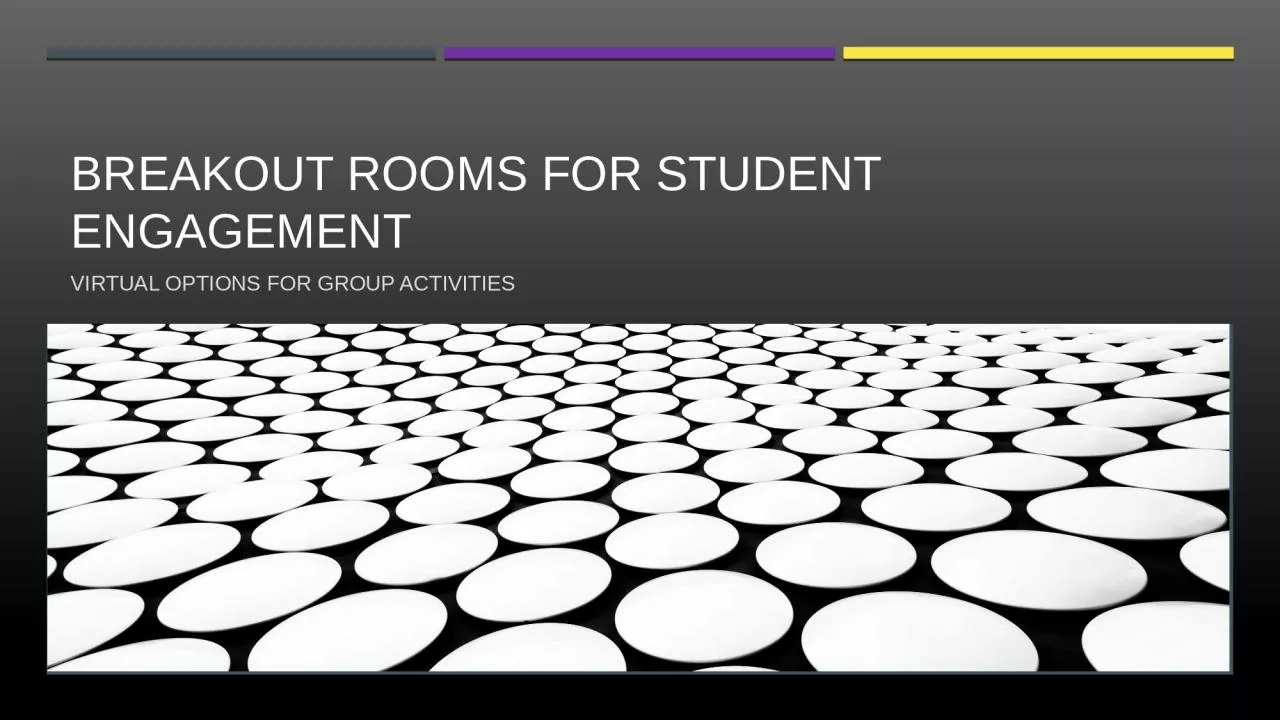

Virtual options for group activities A little review of engagement The Student Engagement Series so far The PrimacyRecency Effect When Learning Takes Place Increase Student Engagement by Leveraging the Learning Management System ID: 1028778
Download Presentation The PPT/PDF document "Breakout Rooms for student engagement" is the property of its rightful owner. Permission is granted to download and print the materials on this web site for personal, non-commercial use only, and to display it on your personal computer provided you do not modify the materials and that you retain all copyright notices contained in the materials. By downloading content from our website, you accept the terms of this agreement.
1. Breakout Rooms for student engagementVirtual options for group activities
2. A little review of engagementThe Student Engagement Series, so far:The Primacy/Recency Effect, When Learning Takes PlaceIncrease Student Engagement by Leveraging the Learning Management SystemImprove Student Engagement with Less TechnologyBreakout Rooms for Student Engagement
3. Session topicsBenefits of Group WorkPlatform Options for Breakout RoomsStrategies & Activities for GroupsSome Things to Keep in Mind
4. Benefits of group workExposes students to a variety of perspectivesHelps students improve their negotiating skillsStudents learn to teach others Boosts critical thinking skills, active learning and independent thinkingEngages students in proactive collaborationImproves social skillsProvides a deeper understanding of the material Increases student engagement
5. Options for breakout roomsVirtual meeting platforms
6. Zoom breakout rooms
7. Ms Teams
8. Google meet
9. webex
10. Breakout planSome suggestions for group activities
11. Round robinPose an open-ended question to all studentsGive them some time to think independentlyCreate breakout rooms of 3 to 8 members and instruct students to allow each person in the group to briefly share their response to the question. Have a designated reporter for each group share their discussion with the entire classThis activity allows every student in your course to share. Be explicit about how much you want students to share (one word, one sentence, or for one minute).
12. Jigsaw Identify a learning module that can be broken into parts (example: students need to read four different research papers about the same or a similar topic).Form small groups and have each group focus on one of the parts (e.g., each group reads one of the four papers). This can be completed asynchronously.During class, allow the groups to discuss their part with the goal of being able to explain it to other classmates.Reform the groups so that each new group has one member that focused on a different part. Each group member now explains their part to the new group.Provide the new groups with a problem to solve that requires the integration of the different parts. Note: Make sure to only use this model for material that sensibly breaks into complementary or dependent parts. Otherwise, students may find little motivation to learn the other parts from their classmates.
13. Escape roomshttps://docs.google.com/forms/d/e/1FAIpQLSflNxNM0jzbZJjUqOcXkwhGTfii4CM_CA3kCxImbY8c3AABEA/viewform
14. Two-stage “exam” Students complete an exam (or exam-like questions) individually, keep a copy of their responses, and submit another copy to the instructor. This can be completed asynchronously, think flipped classroom.Students are put into small groups, complete the same or similar exam, and submit their answers together. It is not necessary that these “exams” be graded or worth a significant portion of a student’s grade. This could be used simply as a learning activity. If you do decide to grade this activity, it is recommended that the individual portion count for 85-90% of the grade and the group portion count for the rest, if the student’s individual score is higher than their group score, their grade will be based solely on their individual score.
15. Create a game or triviaCreate a Kahoot or Quizizz (or any other virtual gaming platform) that is tied to a learning objective. Divide the class into breakout rooms and allow them to compete in the game in small groups. The smaller the group the more likely each student will have a chance to answer and participate.
16. Think-Pair-SharePropose a question and allow students to think independently for some time.Create breakout rooms with two students in each room and ask the students to discuss in pairs. Help students to decide who speaks first and who will be the reporter using an equitable prompt such as selecting the person: whose first name is closest to the end of the alphabet, whose birthday is coming up the soonest, whose hometown is closest to campus, etc.Close breakout rooms and ask all or some reporters to share what they discussed in their pair.
17. Project based learningSeparate the class into teams and assign each team a project.Allow the students to work together in their teams while managing their progress. This could be used as a single class option or a longer term project that spans over several class meetings.
18. Keep in mindSome best practices to consider
19. practices to considerHave a plan. Don’t attempt to do a breakout activity without some idea of how you want it structured and what outcome you would like to achieve. Share instructions for the breakout activity where students can see them. Use a shared document or post within the group activity, if possibleAssign a clear task for students to accomplish, such as brainstorming, coming to a position on a set of questions, etc.Assign roles to students. Assigning roles will help students start the conversation and support equitable participation. (reporter, speaker, scribe…)Teach students to share their screens and use other room features. Make sure your students are comfortable using the platform before you attempt a breakout session.
20. Questions or comments?Thank You!